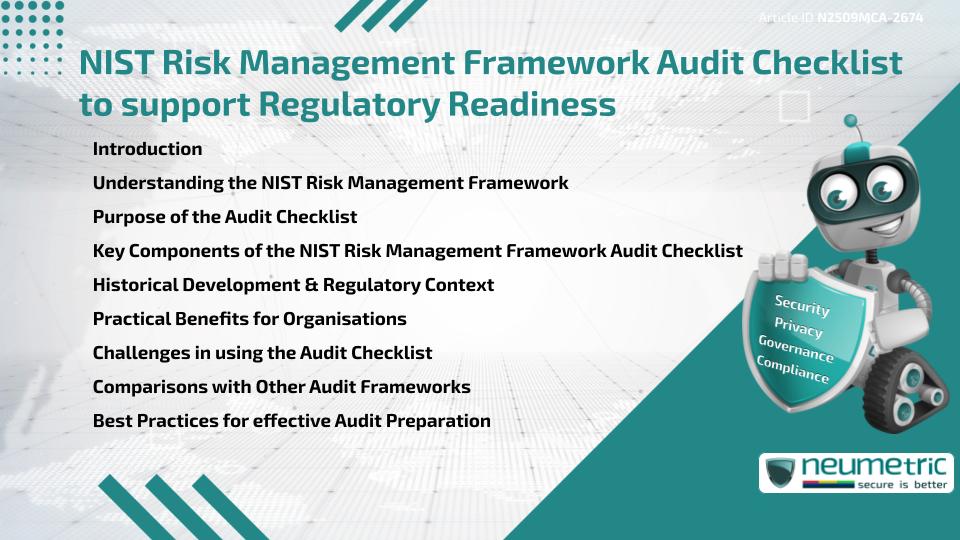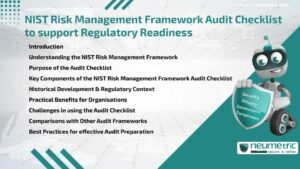Table of Contents
ToggleIntroduction
The NIST Risk Management Framework Audit Checklist is a practical tool designed to help Organisations assess their Compliance with the National Institute of Standards & Technology [NIST] Risk Management Framework [RMF]. By using the Checklist, Organisations can evaluate gaps, prepare for Regulatory Audits & strengthen Internal Risk Management practices. This article explains the Checklist’s purpose, key components, historical context, benefits, limitations & best practices for effective use.
Understanding the NIST Risk Management Framework
The NIST RMF provides a structured, repeatable process for integrating Risk Management into the System Development Life Cycle. It guides Organisations through steps such as categorising Systems, selecting & implementing Controls, assessing effectiveness, authorising use & continuously monitoring Security Posture. The Audit Checklist aligns with these stages to ensure readiness for Regulatory requirements.
Purpose of the Audit Checklist
The primary purpose of the NIST Risk Management Framework Audit Checklist is to help Organisations:
- Identify Compliance Gaps
- Verify Control Implementation
- Prepare for External or Internal Audits
- Maintain continuous Regulatory readiness
It serves as both a Compliance Roadmap & a practical reference for Risk Management Teams.
Key Components of the NIST Risk Management Framework Audit Checklist
An effective Checklist typically covers:
- System Categorisation: Ensuring Systems are classified by impact levels.
- Control Selection: Verifying appropriate Controls are chosen from NIST guidelines.
- Implementation Evidence: Documenting Safeguards & Security Measures.
- Assessment Records: Maintaining results of independent Control Assessments.
- Authorisation Documentation: Recording approval from Senior Officials.
- Continuous Monitoring: Tracking updates, Patches & emerging Risks.
By addressing these components, Organisations maintain a comprehensive Audit trail that supports Accountability & Compliance.
Historical Development & Regulatory Context
The RMF & its Audit Checklist grew out of the Federal Information Security Management Act [FISMA] of 2002, which mandated Federal agencies to adopt standardised Information Security practices. Over time, the Checklist evolved into a broader Compliance Tool, extending to Contractors & Private Organisations seeking alignment with Federal requirements. Its structured approach ensures Organisations meet both Legal & Regulatory obligations.
Practical Benefits for Organisations
Using the NIST Risk Management Framework Audit Checklist offers several benefits:
- Improved Audit preparedness
- Clear Evidence of Compliance efforts
- Reduced Risk of Penalties for Non-Compliance
- Streamlined Internal Audit Processes
- Increased Stakeholder Confidence
These advantages make the Checklist a vital resource for any Organisation working in regulated Industries or handling Sensitive Data.
Challenges in using the Audit Checklist
While valuable, the Checklist can be challenging to implement. Smaller Organisations may lack the resources to document every stage comprehensively. The process can also be time-intensive, requiring ongoing updates to reflect changing Threats & Regulatory requirements. Without proper training, teams may struggle to interpret Checklist items effectively.
Comparisons with Other Audit Frameworks
The RMF Audit Checklist is often compared with ISO 27001 Audit Checklists & COBIT frameworks. While ISO 27001 focuses on building an Information Security management system [ISMS] & COBIT emphasises Governance, the NIST RMF Checklist offers detailed, step-by-step guidance for Compliance with U.S. Federal requirements. Many Organisations combine elements of these frameworks for a more holistic Compliance strategy.
Best Practices for effective Audit Preparation
To maximise the Checklist’s effectiveness, Organisations should:
- Begin Audit preparation early in the System Development Life Cycle
- Involve Cross-functional Teams in Checklist reviews
- Use Automation Tools for Evidence collection
- Conduct regular Internal Audits to validate readiness
- Treat the Checklist as part of a Continuous Improvement effort
Following these practices ensures Audits are less stressful & more efficient while improving overall Risk Management maturity.
Takeaways
- Essential tool for Regulatory Audit preparation
- Provides structure & enhances Compliance
- Strengthens Accountability
- Helps maintain readiness despite Resource challenges
- Reduces Risk & builds Regulatory confidence
FAQ
What is the NIST Risk Management Framework Audit Checklist?
It is a structured tool that helps Organisations verify Compliance with the NIST RMF & prepare for Regulatory Audits.
Why is the Checklist important?
It ensures Organisations identify Gaps, implement Controls properly & maintain continuous Regulatory readiness.
Who should use the Audit Checklist?
Federal Agencies, Contractors & Private Organisations handling Sensitive Data can benefit from the Checklist.
What are the main components of the Checklist?
Components include System categorisation, Control selection, implementation Evidence, Assessment Records, Authorisation & Continuous Monitoring.
What challenges come with using the Checklist?
Challenges include Resource demands, Documentation complexity & the need for ongoing updates.
Can Organisations combine the NIST Checklist with other Frameworks?
Yes, many use it alongside ISO 27001 or COBIT for broader Compliance & Governance coverage.
Need help for Security, Privacy, Governance & VAPT?
Neumetric provides Organisations the necessary help to achieve their Cybersecurity, Compliance, Governance, Privacy, Certifications & Pentesting needs.
Organisations & Businesses, specifically those which provide SaaS & AI Solutions in the Fintech, BFSI & other regulated sectors, usually need a Cybersecurity Partner for meeting & maintaining the ongoing Security & Privacy needs & requirements of their Enterprise Clients & Privacy conscious Customers.
SOC 2, ISO 27001, ISO 42001, NIST, HIPAA, HECVAT, EU GDPR are some of the Frameworks that are served by Fusion – a SaaS, multimodular, multitenant, centralised, automated, Cybersecurity & Compliance Management system.
Neumetric also provides Expert Services for technical security which covers VAPT for Web Applications, APIs, iOS & Android Mobile Apps, Security Testing for AWS & other Cloud Environments & Cloud Infrastructure & other similar scopes.
Reach out to us by Email or filling out the Contact Form…





